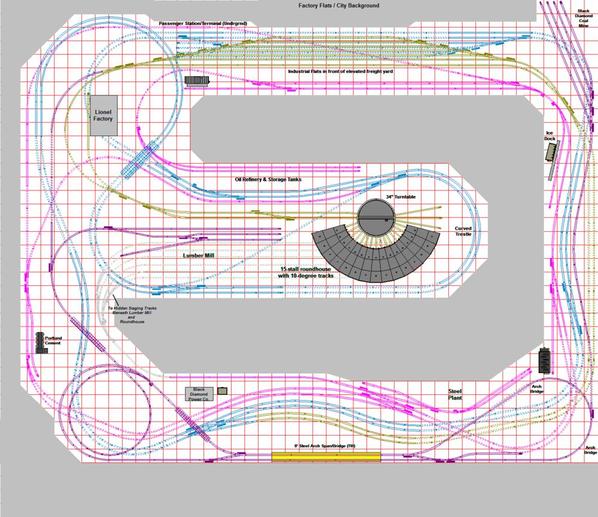Folks,
I've been alluding to a 3-rail, O-Scale, Hi-Rail layout that I've been planning for quite some time now. And while I'm still quite a ways from cutting any lumber, I thought I'd share some preliminary design plans. As you'll see, this is gonna be a HUGE undertaking, so I'd like to get as much "right" in the planning stages. I'm including a Windows BMP file here to give you an idea of the scope of "the project".
The layout will exist in the lower level of what will essentially be my professional office space, and the overall floor space is approximately 45' x 38' with a main staircase that enters the inner portion of the layout (below the lumber mill and roundhouse), and a small spiral staircase that enters the outer aisle-way (at the lower left). A double-door outside entrance to the lower level is also planned directly in front of the TrainWorx 8' Steel Arch Span/Bridge (highlighted in yellow on the plan). Ceilings on this level of the building will be 9' finished, and the ceiling will primarily be black drop-ceiling tiles with track lighting throughout to highlight various portions of the layout. Wall backgrounds are planned for the left (rolling hills), top (urban/factory) and right (mountain scenery) walls -- with the left and top walls having an access aisle-way. The bottom wall will have the walk-out entrance, windows for daylight, and also wall-space for train shelves.
There's a lot going here... and you need to think 3-dimensionally to get a feel for the overall plan. Hopefully, clicking on the attached BMP file will give you a large enough view to read the labels, and get a glimpse of how this all fits together. Here's a key that should definitely help though:
- Dark Purple [Level4]: Upper Level Branch Line that is logging route which also serves the coal mine (upper left right corner of the plan).
- Olive Green [Level3]: Engine service terminal with 15-stall roundhouse, freight classification yard, and twin yard lead to the double-track mainline.
- Blue [Level2]: Double-Track Mainline with an underground passenger terminal (along the top wall of the plan).
- Bright Purple [Level1]: Lower Level Branch Line that serves a variety of industries.
- Very Light Gray [Level0]: Hidden 6-track staging yard (directly beneath the lumber mill and roundhouse).
Each of these colors depicts what is essentially a unique level on the layout, with the hidden staging yard being the lowest level, and the upper branch line to the coal mine being the highest level. I'm still double-checking grades throughout, but the goal is to keep grades below 2%. So far... so good.
As I indicated earlier... nothing is ground in stone here, and I'd like to do this right the first time. My intention was to design a plan that provided for continuous running when I wanted to just watch the trains run. But also have enough in the way of industries, yards, an engine service terminal, and a large passenger terminal to provide "operational interest" as well.
I will very likely have 2 or 3 access hatches in the upper left portion of the plan where you see the Lionel Factory. But aside from that area, I had hoped to keep things within a 4-6' reach max.
Very interested to hearing feedback on this design. Thanks for taking the time to browse the layout plan!
David







